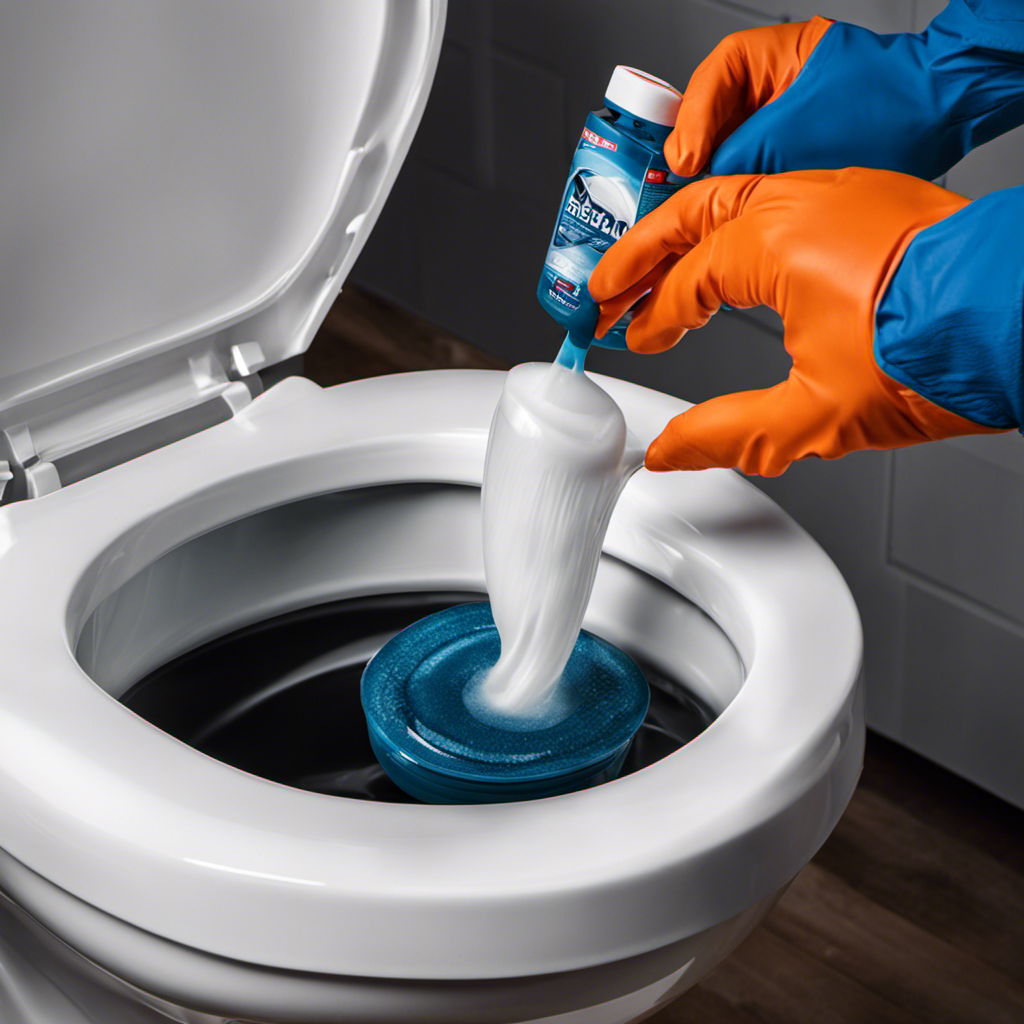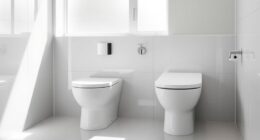Hey there! Ever dealt with a slow filling toilet tank? It can be a real pain, am I right?
Well, fear not, because I’m here to share some expert tips on how to fix this pesky issue. From checking the water supply valve to inspecting and adjusting the fill valve, we’ll cover all the technical details to get your toilet tank filling up efficiently in no time.
So, let’s dive in and get that toilet tank back up to speed!
Key Takeaways
- Clogged fill valve or mineral deposits can cause a slow filling toilet tank.
- Cleaning the fill valve with vinegar or descaling solution can dissolve deposits.
- Checking and inspecting the water supply valve for potential issues.
- Troubleshooting and inspecting the fill valve can help identify and resolve problems.
Possible Causes of a Slow Filling Toilet Tank
One possible cause of your slow filling toilet tank is a clogged fill valve. When the fill valve gets clogged, it restricts the flow of water into the tank, resulting in a slow filling process. This can lead to several issues, including a toilet tank overflow and water pressure issues.
A clogged fill valve is often caused by mineral deposits or debris that accumulate over time. These deposits can prevent the valve from fully opening, causing water to trickle into the tank instead of filling it quickly.
To resolve this issue, you can try cleaning the fill valve by removing it and soaking it in vinegar or a descaling solution. This will help dissolve any deposits and restore proper water flow. However, if the problem persists, it is advisable to check the water supply valve for any potential issues.
Check the Water Supply Valve
To ensure proper water flow, it’s important to check the water supply valve for any blockages or leaks. The water supply valve controls the flow of water into the toilet tank and can be a common source of issues with slow filling tanks.
Start by locating the valve, usually located behind the toilet near the wall. Turn the valve clockwise to shut off the water supply. Inspect the valve for any signs of damage or leaks, such as cracks or water puddles.
If everything looks fine, turn the valve counterclockwise to open it fully and check the water pressure. Low water pressure can also cause slow filling tanks.
If the water supply valve is functioning properly and the water pressure is adequate, then the issue may lie with clogged pipes.
Inspect the Fill Valve
When it comes to inspecting the fill valve, it is important to consider valve replacement options and troubleshooting common issues.
To ensure optimal performance, it is essential to have knowledge of the various valve replacement options available in the market.
Additionally, troubleshooting common issues such as leaks, weak water flow, or inconsistent water levels can help identify and resolve any problems with the fill valve.
Valve Replacement Options
If you’re looking for valve replacement options, you should consider using a fill valve with adjustable height. These valves are specifically designed to regulate the water level in your toilet tank, ensuring a consistent and efficient fill.
Here are some key benefits of using a fill valve with adjustable height:
-
Versatility: With adjustable height settings, you can easily customize the water level in your toilet tank to suit your needs.
-
Ease of Installation: These fill valves are designed for easy installation, making it a hassle-free process for anyone, even those with limited plumbing experience.
-
Improved Efficiency: By maintaining the correct water level, a fill valve with adjustable height helps optimize water usage, saving you money on your water bill.
By choosing a fill valve with adjustable height, you can easily maintain your valve and troubleshoot any issues that may arise.
Now, let’s move on to discussing common troubleshooting techniques for toilet tank fill valves.
Troubleshooting Common Issues
One way to address common issues with your fill valve is by adjusting the water level in your toilet tank. If you are experiencing toilet tank leaks or water pressure issues, adjusting the water level can help alleviate these problems.
To adjust the water level, locate the fill valve in your toilet tank. This valve controls the flow of water into the tank. Using a screwdriver, turn the adjustment screw on the fill valve clockwise to raise the water level or counterclockwise to lower it.
It’s important to find the right water level to ensure proper flushing and prevent any leaks. If adjusting the water level doesn’t solve the problem, you may need to replace the fill valve altogether.
Adjust the Fill Valve’s Water Level
To adjust the fill valve’s water level in your slow filling toilet tank, you’ll need to locate the adjustment screw. This screw is usually found on top of the fill valve, which is connected to the float ball or cup.
Here are some adjustment techniques and troubleshooting tips to help you out:
-
Turn the adjustment screw clockwise to increase the water level. This will allow more water to enter the tank during each fill cycle.
-
If the water level is too high and overflowing into the overflow tube, turn the adjustment screw counterclockwise to lower the water level.
-
Make small adjustments at a time and test the water level after each adjustment to find the optimal setting.
Clean or Replace the Toilet Tank Flapper
When it comes to maintaining the toilet tank flapper, there are a few key tips to keep in mind.
First, it is important to regularly clean the flapper to prevent any buildup or clogs.
Additionally, keeping an eye out for signs of flapper damage, such as leaks or inconsistent flushing, can help identify when it may be time for a replacement.
Lastly, choosing the right flapper for your toilet is crucial, as the wrong fit can lead to further issues down the line.
Flapper Maintenance Tips
Make sure you check the flapper for any signs of wear or damage before proceeding with any maintenance. Flapper maintenance techniques are essential to ensure the proper functioning of your toilet tank.
Here are some flapper repair solutions that can help you maintain your toilet’s efficiency:
-
Inspect: Carefully examine the flapper for cracks, discoloration, or deterioration. Look for any signs of wear around the edges or hinge points.
-
Clean: Remove any debris or mineral buildup that may be preventing the flapper from closing properly. Use a soft brush or cloth to gently scrub away any residue.
-
Adjust: If the flapper isn’t sealing properly, you can try adjusting the chain length or the float level to achieve a better fit.
Signs of Flapper Damage
Inspect your flapper for any visible cracks, discoloration, or signs of wear. A damaged flapper can lead to a host of problems with your toilet, including slow tank filling and water leakage.
To diagnose flapper damage, start by examining the rubber material for any visible cracks or tears. Discoloration may indicate that the flapper has been exposed to harsh chemicals or minerals, which can compromise its integrity. Additionally, signs of wear such as frayed edges or a loose fit should not be ignored.
If you notice any of these issues, it is crucial to replace the flapper promptly. Flapper replacement is a common toilet repair that can restore proper functionality and prevent water wastage.
Don’t delay, address flapper damage promptly to avoid further complications.
Choosing the Right Flapper
To ensure proper functioning of your bathroom, you should choose the right flapper for your toilet. Flappers are essential components of the toilet tank that regulate the water flow during each flush.
When it comes to flapper replacement, it is important to consider the following flapper types:
-
Rubber Flapper: This common type of flapper is durable and provides a tight seal, preventing water from leaking into the bowl.
-
Adjustable Flapper: This versatile flapper allows you to adjust the amount of water used during each flush, promoting water conservation.
-
Dual Flush Flapper: This innovative flapper offers two flush options, giving you control over water consumption and reducing your environmental impact.
Consider Upgrading to a High-Efficiency Toilet
Consider upgrading to a high-efficiency toilet if you want to save water and improve the filling speed of your toilet tank.
High-efficiency toilets, also known as HETs, are designed to use less water per flush compared to traditional toilets. By using advanced flushing technology, these toilets can effectively remove waste while using only 1.28 gallons of water or less per flush. This significant reduction in water consumption not only helps the environment but also lowers your water bills.
The benefits of high-efficiency toilets go beyond water savings. They also tend to have faster tank refill times, ensuring that your toilet is ready for the next use more quickly.
While the initial cost of a high-efficiency toilet may be higher, the long-term savings on water bills make it a worthwhile investment.
Conclusion
After going through the troubleshooting steps, I was able to fix my slow filling toilet tank.
I discovered that the water supply valve was partially closed, so I opened it fully to allow for proper water flow.
Additionally, I adjusted the fill valve’s water level to ensure it was filling the tank to the correct level.
I also cleaned the toilet tank flapper, which was causing a blockage.
Finally, I upgraded to a high-efficiency toilet for better performance.
Now, my toilet fills up in a flash, like a speeding bullet!










